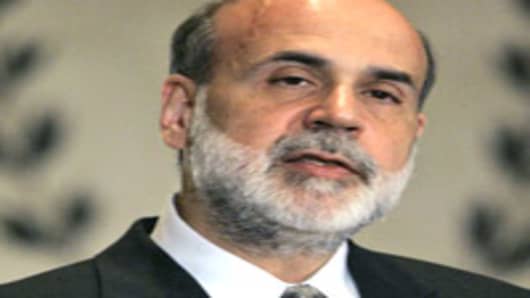Though there’s been much debate over how much the Federal Reserve should cut interest rates Wednesday, what the central bank says in its accompanying statement may be more important to both the Fed’s credibility and market expectations going forward.
Having slashed interest rates three-quarters of a point just a week ago and with economic data continuing to show mixed signals about recession, the Fed not only needs to be clearer about its decision today but also its hints about policy in the future.
“The bigger the rate change, the more the Fed will try to communicate it is in a wait-and-see mode, said David Resler, chief economist at Nomura International.
Nevertheless, regardless of whether it is a quarter- or half-point cut, Resler says the FOMC statement needs to indicate that the Fed has “gone a long way to restoring the federal funds rate to a level that is appropriate to an economy on an uncertain course and that news over the next several weeks will determine what else to be done."
The language is more important than usual for several reasons.
On a practical level, four of the voting positions on the FOMC change hands with this meeting, meaning different opinions will figure into the debate and vote and then presumably be reflected in the statement.
On a policy level, now that the Fed has been cutting rates for five months, it has to suggest some sort of progress and provide a big picture view of the monetary easing's likely impact on the economy.
Tale Of Two FOMC Statements
Complicating the issue is that the Fed cut rates just last week-–doing so in a rare intra-meeting move--and the accompanying statement was a significant departure from the one from the regularly scheduled FOMC meeting in December.
For one, the January statement clearly put more emphasis on the economy than inflation and in doing so also altered its description on the state of the economy.
The Fed said “appreciable downside risks to growth remain,” whereas in the previous statement it merely said “economic growth is slowing.”
Moreover, the January 22 statement devoted one sentence to inflation--versus two in the previous one--and failed to even mention key phrases such as “inflation risks remain” and “foster price stability.”
Though some economists say the abbreviated language simply reflects the fact that FOMC members were participating in an important conference call meant to address the urgent need for a rate cut, other economists say it is both a reflection of how the Fed may have understated things a month ago and that the central bank has to some extent taken its eye off of inflation.
“The Fed went back to easing aggressively and now you're not going to get relief on the inflation side,” warns Robert Brusca, chief economist at Fact And Opinion Economics.
Greenspan Wrote The Book
Such subtleties in the language are not lost on Fed watchers or market mavens. The Greenspan Fed was famous for the repeated use of operative phrases, particularly in its later years, which expertly managed market expectations.
When it kept rates at a historic low several years ago, its policy statement repeatedly referred to the Fed being able to be "patient.” When it repeatedly and gradually raised rates by a quarter point after that period, the Fed reminded people that “policy accommodation can be removed at a pace that is likely to be measured.”
The Bernanke Fed has to be unusually careful. It can't, for instance, say exactly the same thing it said a week ago and thus imply more aggressive policy measures but it also can’t say things too much differently for the same reason, thus ruling out any further cuts--sooner or later.
“What he needs to say is: ‘I’m going to cut rates as much as I need to head off or limit the downturn,” says David Jones, president at DMJ Advisors. “He needs to keep his options open. You can't be too transparent, but you have to give guidance.”
Resler says the Fed needs to drop “appreciable downside risk” and simply say “downside risk," while also communicating that data is mixed, if not tricky, and that it bears close watching.
Resler, Jones and other Fed watchers say one of the weaknesses of the the Bernanke Fed has been communication – and thus a tendency to confound or surprise the markets -- even though the chairman is decidedly more transparent than his predecessor. Some economists admit to not even understanding the Fed’s recent policy moves – in particular or in sum.
Who's In Charge?
Jones, for one, says Bernanke has failed to rise to a level where only the comments of the chairman--and possibly Vice Chairman Donald Kohn--matter to the market. Bernanke's democratic tendencies, Jones adds, have allowed regional bank presidents and board governors to have too many opinions and say too much.
Former Fed Vice Chairman Alan Blinder told CNBC that the same situation existed with Greenspan early in his tenure but that the other opinions eventually failed to matter to the markets,
Jones suggests Bernanke give more speeches–-especially in between meetings–-so the markets know what he is thinking and Bernanke has chances to give hints.
“Speak forcefully, but not be as transparent about the nitty-gritty,” explains Jones, who adds with a chuckle, “Its kind of like corporate guidance.”
Guidance will be key in the FOMC statement Wednesday, especially now that some accuse Bernanke of being both behind the curve and captive to the wants of the market.
In that way, Bernanke needs to send two strong messages: One is that he and the FOMC understand the problem and know what to do; the other – and probably more difficult one to achieve--is that Bernanke is in charge and his opinion is the one that counts.
“At some point you have to tell the market: ‘You're nuts.'” says Ram Bhagavatula, managing director at the hedge fund Combinatorics Capital.



